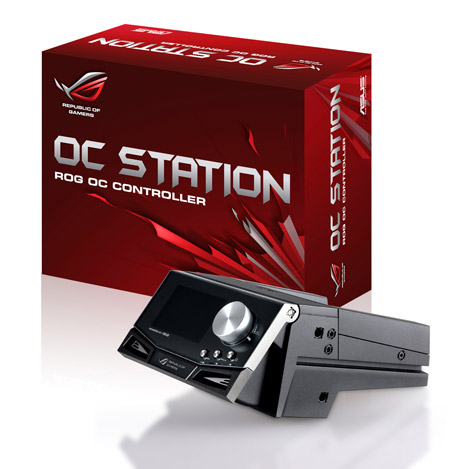Asus Unveils Standalone Overclocking Device

Recently Asus revealed its ROG (Republic of Gamers) OC Station, a hardware-based, bay mounted device made especially for its ROC motherboards.
Taking up two 5.25-inch bays, the device provides a large 3-inch TFT-LED display, an adjustable faceplate (tilts upwards 30 degrees), and enough tweaking goodness that could very well deem it as an overclocker's "holy grail."
According to Asus, the OC Station grants users on-the-fly access to a multitude of overclocking parameters via the large rotary switch mounted on the front. Users can adjust fan speeds as well as manipulate system voltages and frequencies in real-time without the need to load up the BIOS. The OC Station also provides easy access to system information, and will even manage ROG-exclusive features such as CPU Level Up (lets users overclock to a faster processor setting) and the ASUS EPU-6 Engine (moderates power in real-time) at a hardware level. Asus also threw in a photo slideshow function, although the company did not elaborate on how this function serves in the overall overclocking process.
"Bold and futuristic, the OC Station's sports car-inspired design is a reflection of its value proposition: control, speed, precision, and power," the company said. "It is easily the most stylish OC controller on the market, a gleaming testament of ASUS' belief that cutting-edge function should come in a cutting-edge form. The OC Station can be installed in virtually any PC case, where it occupies two 5.25-inch drive bays."
While Asus didn't present a long list of hardware specifications, the company did say that the OC Station provides alarm thresholds with audio alerts, temperature monitoring for critical components, output to four fans, and an "intuitive" user interface. Additionally, the OC Station isn't required to fit within the two 5.25-inch drive bays; it can actually sit on the desktop like a portable, old school radio.
Get Tom's Hardware's best news and in-depth reviews, straight to your inbox.
-
Shadow703793 Nice little gadget. I wouldn't personally do any OCing through it but I would hack it to display temps via RealTemp or calibrated SpeedFan; main reason for hacking it is because those onboard readings from the BIOS/manufacture software can be off as much as by 10-15C. Or hack it to display a music player,widgets,etc.Reply -
ViPr i'm not a luddite so don't insult me but i don't really understand why people bother with overclocking when the gains are so negligible. i would understand if it could boost the performance by multiple times but it doesn't even get close to doubling performance.Reply -
dragonfang18 Dont you mean ROG motherboards?Reply
That would be cool if they actually told us how it works in the OC process... -
joex444 ViPri'm not a luddite so don't insult me but i don't really understand why people bother with overclocking when the gains are so negligible. i would understand if it could boost the performance by multiple times but it doesn't even get close to doubling performance.Reply
If you can take a quad core 2.4GHz, say the Q6600, to 3.2GHz that's a 50% improvement in performance for absolutely no cost. I bought a Q6600 for $190 (OEM). A retail 3.0GHz quad core is $325. They don't even make a LGA775 3.2GHz quad. So to get that performance, I could have spent an extra $135 or simply overclocked. (And, yes, you do need a nicer motherboard. But you do not need one that costs $135 more than the entry-level tier-1 boards). Oh, and running a higher FSB and RAM speed also improves performance somewhat.
Or how about the previous OC I had, before going quad core? Same board, took an E4300 at 1.8GHz to 2.93GHz. At the time I bought this, the fastest CPUs under $500 was a 2.66GHz dual core. I mean, this was like mid-2006. The E4300 was under $200. You kind of see the point here? Do you really need a 3.2GHz quad, or a 2.93GHz dual core (three years ago)? No, but why run a 2.4GHz quad or a 1.8GHz dual (honestly, not fast) when the faster speeds are available for free?
-
B-Unit ViPri'm not a luddite so don't insult me but i don't really understand why people bother with overclocking when the gains are so negligible. i would understand if it could boost the performance by multiple times but it doesn't even get close to doubling performance.It depends what/how much you overclock. I took an Opteron165 which comes stock at 1.8Ghz and was able to OC all the way to 2.9Ghz, which I would have had to have paid many times as much money to get with a stock clocked CPU.Reply
There are many stories of E2x00 Pentium Dual Cores going from 1.8-2.0 Ghz to nearly 4.0Ghz, potentially doubling performance. Overclocking is a way to get top-tier performance for entry-level prices. -
computabug Aww Gigabyte should make something like this...Reply
ViPr got schooled... maybe he has a P4 or something that doesn't OC very well :p But he has a small point, some people do spend hundreds of dollars on water cooling+e5200, when instead, they could just spend a bit more and get an air cooler+e8400 for less and better performance. Just an example :P And then they fry it, wasting all their efforts and money altogether :D
But yes, joex444 is right. Core 2's overclock very nicely with just about any motherboards, and if you're on a very tight budget with the worst C2D chip, you can even OC with a stock cooler, since C2D's don't produce that much heat...